HONDA CLARITY FUEL CELL 2021 Owner's Manual (in English)
Manufacturer: HONDA, Model Year: 2021, Model line: CLARITY FUEL CELL, Model: HONDA CLARITY FUEL CELL 2021Pages: 555, PDF Size: 28.21 MB
Page 421 of 555
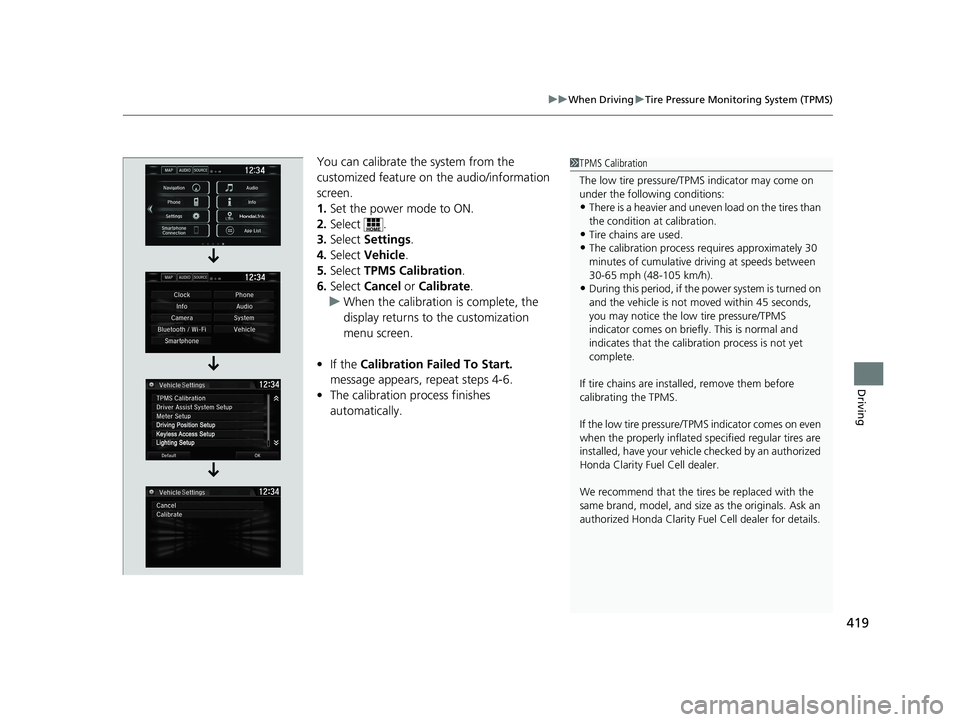
419
uuWhen Driving uTire Pressure Monitoring System (TPMS)
Driving
You can calibrate the system from the
customized feature on the audio/information
screen.
1. Set the power mode to ON.
2. Select .
3. Select Settings .
4. Select Vehicle .
5. Select TPMS Calibration .
6. Select Cancel or Calibrate .
u When the calibration is complete, the
display returns to the customization
menu screen.
• If the Calibration Failed To Start.
message appears, repeat steps 4-6.
• The calibration process finishes
automatically.1TPMS Calibration
The low tire pressure/TPMS indicator may come on
under the following conditions:
•There is a heavier and uneve n load on the tires than
the condition at calibration.
•Tire chains are used.
•The calibration process requires approximately 30
minutes of cumulative dr iving at speeds between
30-65 mph (48-105 km/h).
•During this period, if the power system is turned on
and the vehicle is not moved within 45 seconds,
you may notice the low tire pressure/TPMS
indicator comes on briefl y. This is normal and
indicates that the calibr ation process is not yet
complete.
If tire chains are installed, remove them before
calibrating the TPMS.
If the low tire pressure/TPMS indicator comes on even
when the properly inflated specified regular tires are
installed, have your vehicl e checked by an authorized
Honda Clarity Fuel Cell dealer.
We recommend that the tires be replaced with the
same brand, model, and size as the originals. Ask an
authorized Honda Clarity Fuel Cell dealer for details.
21 CLARITY FCV CSS-31TRT6400_02.book 419 ページ 2020年9月25日 金曜日 午 後3時15分
Page 422 of 555
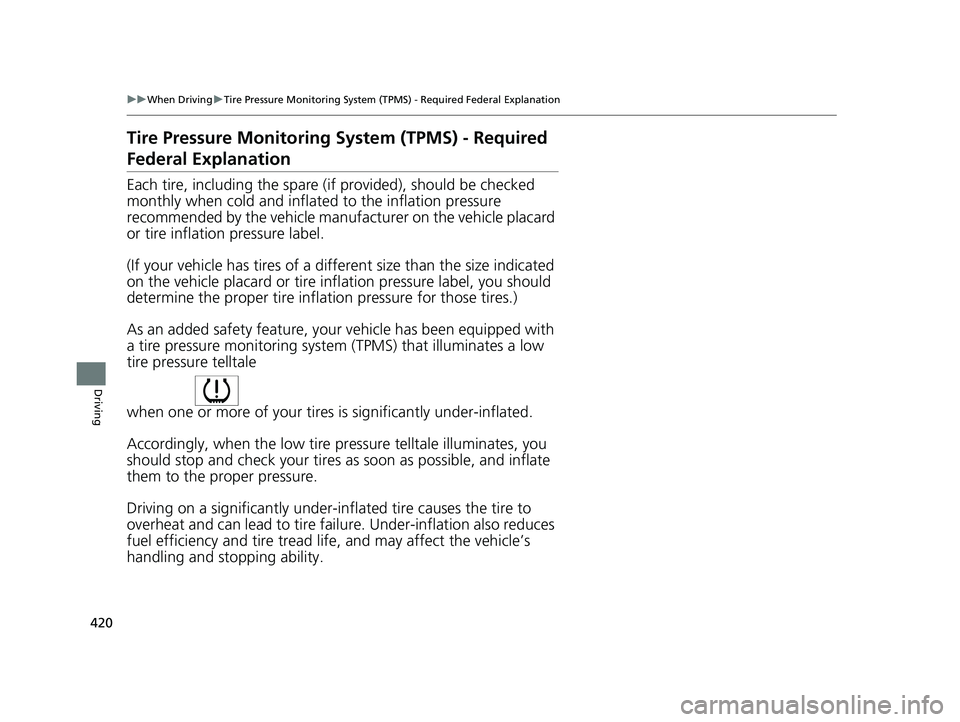
420
uuWhen Driving uTire Pressure Monitoring System (TPMS) - Required Federal Explanation
Driving
Tire Pressure Monitoring System (TPMS) - Required
Federal Explanation
Each tire, including the spare (i f provided), should be checked
monthly when cold and inflated to the inflation pressure
recommended by the vehicle manufacturer on the vehicle placard
or tire inflation pressure label.
(If your vehicle has tires of a different size than the size indicated
on the vehicle placard or tire infl ation pressure label, you should
determine the proper tire inflat ion pressure for those tires.)
As an added safety feature, your vehicle has been equipped with
a tire pressure monitoring system (TPMS) that illuminates a low
tire pressure telltale
when one or more of your tire s is significantly under-inflated.
Accordingly, when the low tire pr essure telltale illuminates, you
should stop and check your tires as soon as possible, and inflate
them to the proper pressure.
Driving on a significantly under-in flated tire causes the tire to
overheat and can lead to tire fail ure. Under-inflation also reduces
fuel efficiency and tire tread li fe, and may affect the vehicle’s
handling and stopping ability.
21 CLARITY FCV CSS-31TRT6400_02.book 420 ページ 2020年9月25日 金曜日 午 後3時15分
Page 423 of 555
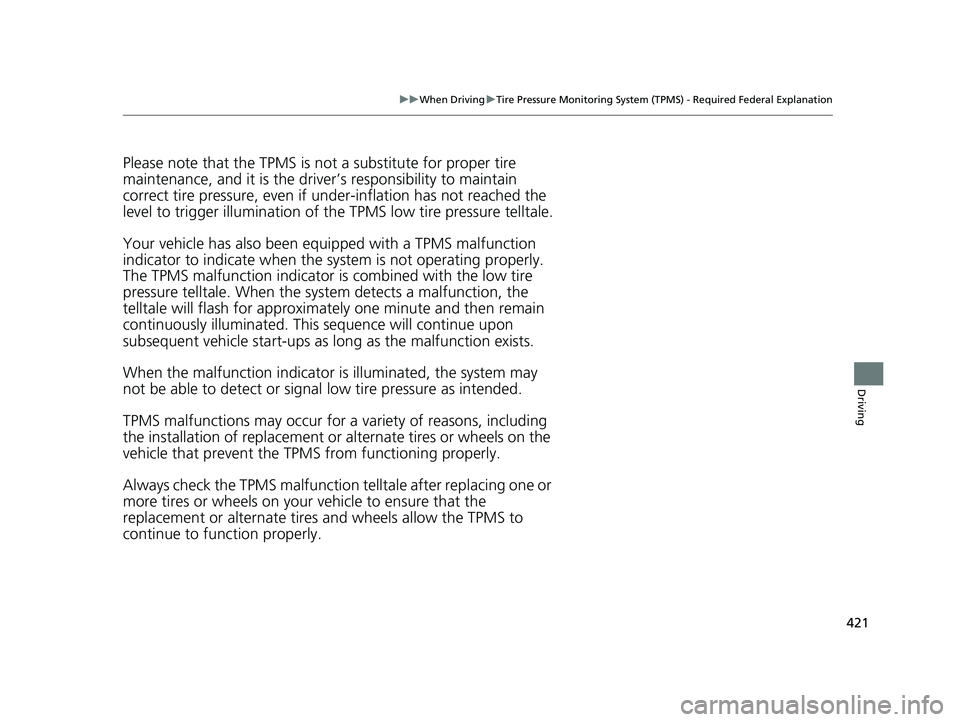
421
uuWhen Driving uTire Pressure Monitoring System (TPMS) - Required Federal Explanation
Driving
Please note that the TPMS is not a substitute for proper tire
maintenance, and it is the driver ’s responsibility to maintain
correct tire pressure, even if un der-inflation has not reached the
level to trigger illumination of th e TPMS low tire pressure telltale.
Your vehicle has also been equi pped with a TPMS malfunction
indicator to indicate when the system is not operating properly.
The TPMS malfunction indicator is combined with the low tire
pressure telltale. When the syst em detects a malfunction, the
telltale will flash fo r approximately one minute and then remain
continuously illumina ted. This sequence will continue upon
subsequent vehicle start-ups as long as the malfunction exists.
When the malfunction indicator is illuminated, the system may
not be able to detect or signal low tire pressure as intended.
TPMS malfunctions may occur for a variety of reasons, including
the installation of replacement or alternate tires or wheels on the
vehicle that prevent the TPMS from functioning properly.
Always check the TPMS malfunction telltale after replacing one or
more tires or wheels on your vehicle to ensure that the
replacement or alternate tires and wheels allow the TPMS to
continue to function properly.
21 CLARITY FCV CSS-31TRT6400_02.book 421 ページ 2020年9月25日 金曜日 午 後3時15分
Page 424 of 555
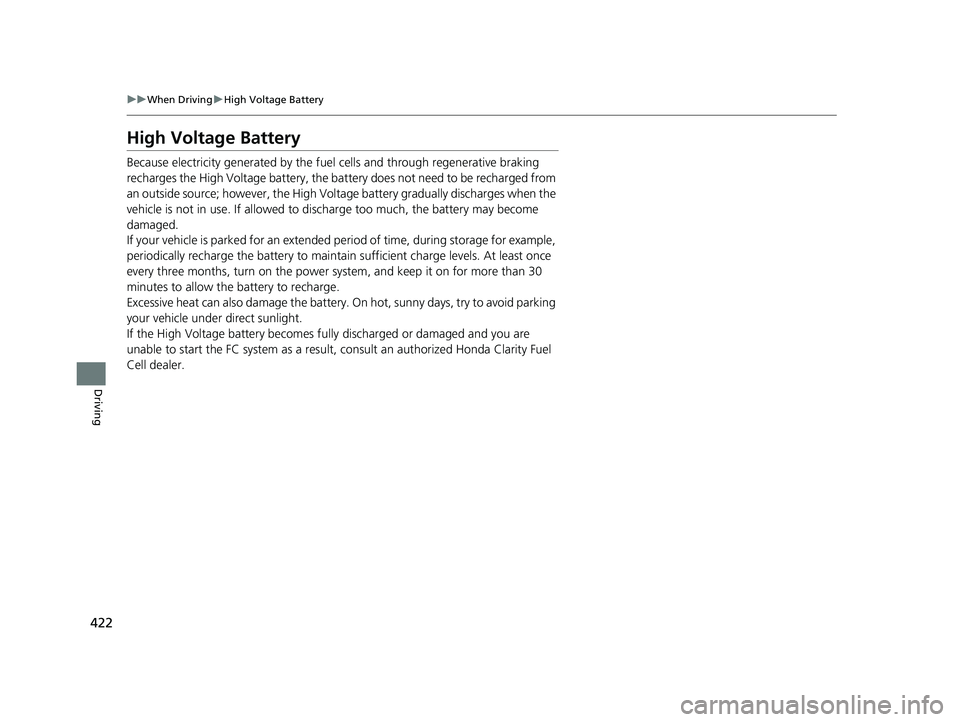
422
uuWhen Driving uHigh Voltage Battery
Driving
High Voltage Battery
Because electricity generated by the fuel cells and through regenerative braking
recharges the High Voltage battery, the batte ry does not need to be recharged from
an outside source; however, th e High Voltage battery gradually discharges when the
vehicle is not in use. If allowed to discharge too much, the battery may become
damaged.
If your vehicle is parked for an extended pe riod of time, during storage for example,
periodically recharge the battery to maintain sufficient charge levels. At least once
every three months, turn on the power sy stem, and keep it on for more than 30
minutes to allow the battery to recharge.
Excessive heat can also damage the battery . On hot, sunny days, try to avoid parking
your vehicle under direct sunlight.
If the High Voltage battery becomes full y discharged or damaged and you are
unable to start the FC system as a result , consult an authorized Honda Clarity Fuel
Cell dealer.
21 CLARITY FCV CSS-31TRT6400_02.book 422 ページ 2020年9月25日 金曜日 午 後3時15分
Page 425 of 555
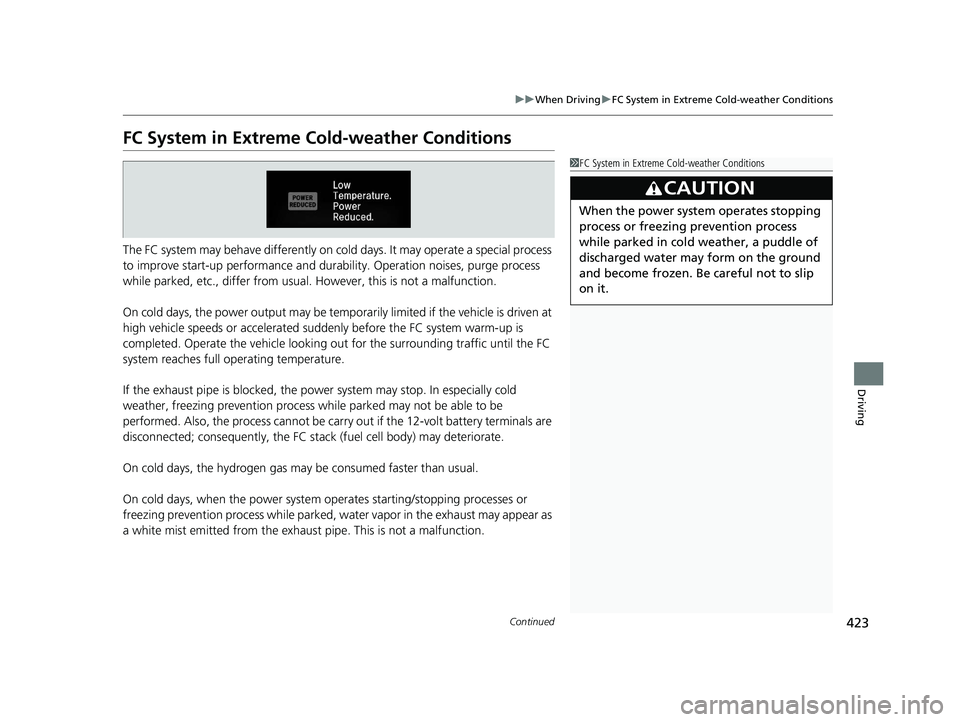
423
uuWhen Driving uFC System in Extreme Cold-weather Conditions
Continued
Driving
FC System in Extreme Cold-weather Conditions
The FC system may behave differently on co ld days. It may operate a special process
to improve start-up performance and dura bility. Operation noises, purge process
while parked, etc., differ from usual. However, this is not a malfunction.
On cold days, the power output may be temporarily limited if the vehicle is driven at
high vehicle speeds or accelerated sudden ly before the FC system warm-up is
completed. Operate the vehicle looking out for the surrounding traffic until the FC
system reaches full operating temperature.
If the exhaust pipe is blocked, the power system may stop. In especially cold
weather, freezing prevention process wh ile parked may not be able to be
performed. Also, the process cannot be carr y out if the 12-volt battery terminals are
disconnected; consequently, the FC stack (fuel cell body) may deteriorate.
On cold days, the hydrogen gas may be consumed faster than usual.
On cold days, when the power system operates starting/stopping processes or
freezing prevention process while parked, wa ter vapor in the exhaust may appear as
a white mist emitted from the exhaust pipe. This is not a malfunction.
1 FC System in Extreme Cold-weather Conditions
3CAUTION
When the power system operates stopping
process or freezing prevention process
while parked in cold weather, a puddle of
discharged water may form on the ground
and become frozen. Be careful not to slip
on it.
21 CLARITY FCV CSS-31TRT6400_02.book 423 ページ 2020年9月25日 金曜日 午 後3時15分
Page 426 of 555
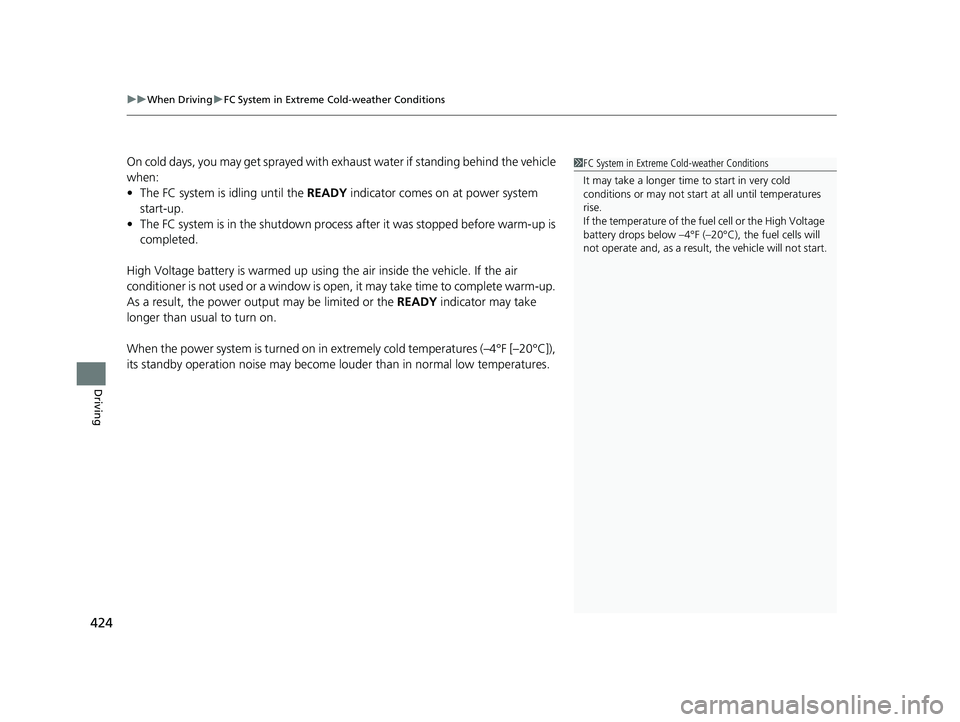
uuWhen Driving uFC System in Extreme Cold-weather Conditions
424
Driving
On cold days, you may get sprayed with ex haust water if standing behind the vehicle
when:
• The FC system is idling until the READY indicator comes on at power system
start-up.
• The FC system is in the shutdown proces s after it was stopped before warm-up is
completed.
High Voltage battery is warmed up using the air inside the vehicle. If the air
conditioner is not used or a window is open, it may take time to complete warm-up.
As a result, the power output may be limited or the READY indicator may take
longer than usual to turn on.
When the power system is turned on in ex tremely cold temperatures (–4°F [–20°C]),
its standby operation noise may become l ouder than in normal low temperatures.1FC System in Extreme Cold-weather Conditions
It may take a longer time to start in very cold
conditions or may not start at all until temperatures
rise.
If the temperature of the fuel cell or the High Voltage
battery drops below –4°F (– 20°C), the fuel cells will
not operate and, as a result, the vehicle will not start.
21 CLARITY FCV CSS-31TRT6400_02.book 424 ページ 2020年9月25日 金曜日 午 後3時15分
Page 427 of 555
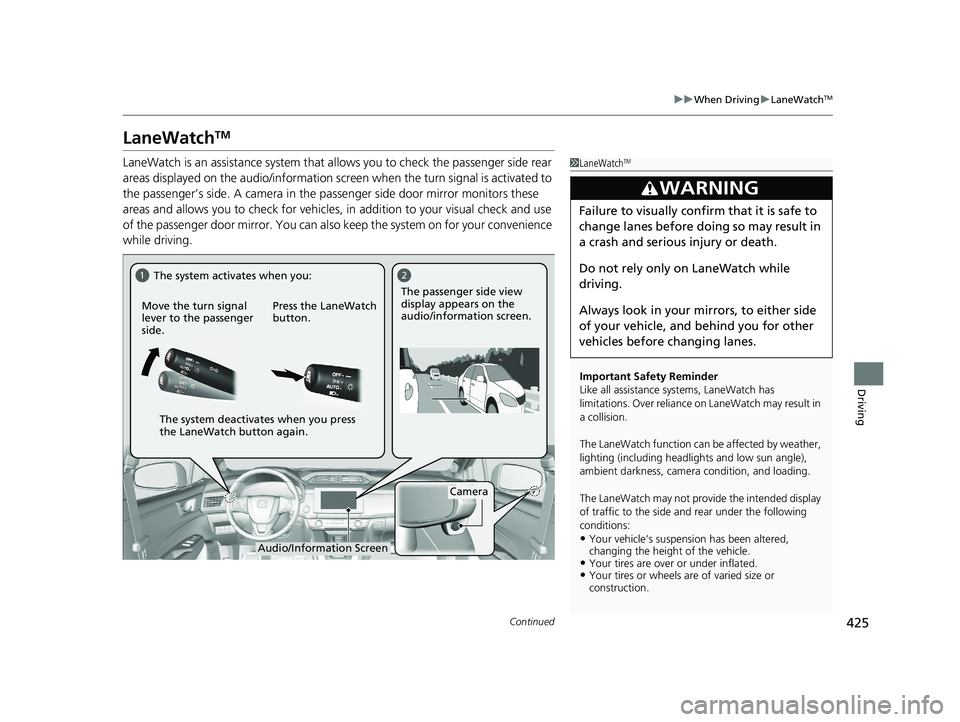
425
uuWhen Driving uLaneWatchTM
Continued
Driving
LaneWatchTM
LaneWatch is an assistance system that al lows you to check the passenger side rear
areas displayed on the audio/information screen when the turn signal is activated to
the passenger’s side. A camera in the pa ssenger side door mirror monitors these
areas and allows you to check for vehicles, in addition to your visual check and use
of the passenger door mirror. You can also keep the system on for your convenience
while driving.1 LaneWatchTM
Important Safety Reminder
Like all assistance systems, LaneWatch has
limitations. Over reliance on LaneWatch may result in
a collision.
The LaneWatch func tion can be affected by weather,
lighting (including headli ghts and low sun angle),
ambient darkness, camera condition, and loading.
The LaneWatch may not prov ide the intended display
of traffic to the side and rear under the following
conditions:
•Your vehicle’s suspension has been altered,
changing the height of the vehicle.
•Your tires are over or under inflated.•Your tires or wheels are of varied size or
construction.
3WARNING
Failure to visually confirm that it is safe to
change lanes before doing so may result in
a crash and serious injury or death.
Do not rely only on LaneWatch while
driving.
Always look in your mi rrors, to either side
of your vehicle, and behind you for other
vehicles before changing lanes.
12
Camera
Move the turn signal
lever to the passenger
side.
Press the LaneWatch
button.The passenger side view
display appears on the
audio/information screen.
The system activates when you:
The system deactivates when you press
the LaneWatch button again.
Audio/Information Screen
21 CLARITY FCV CSS-31TRT6400_02.book 425 ページ 2020年9月25日 金曜日 午 後3時15分
Page 428 of 555
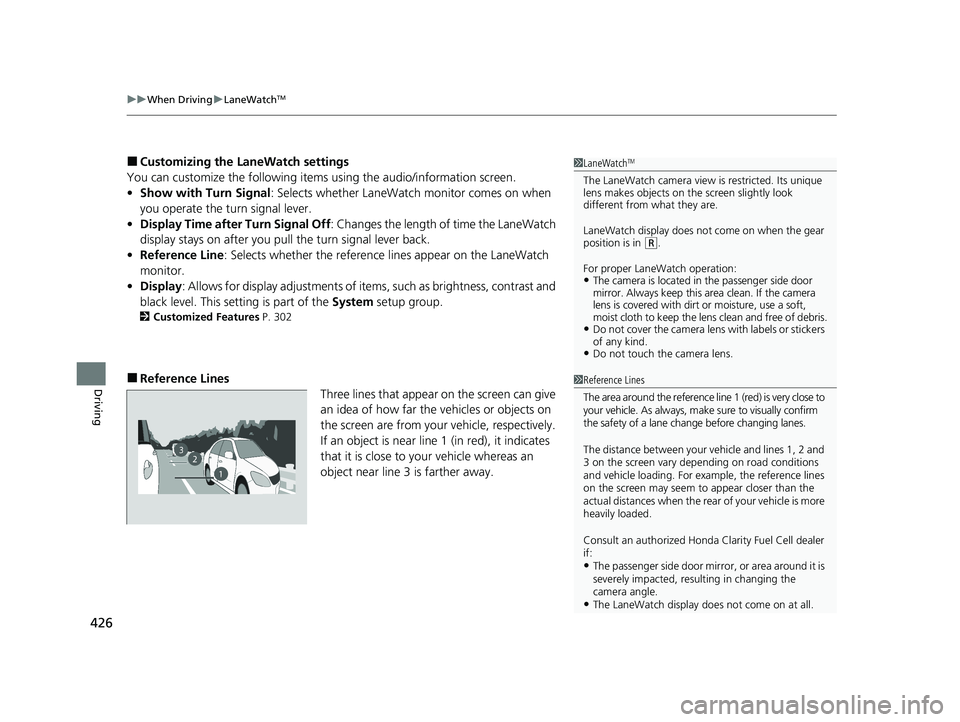
uuWhen Driving uLaneWatchTM
426
Driving
■Customizing the LaneWatch settings
You can customize the following items using the audio/information screen.
• Show with Turn Signal : Selects whether LaneWatch monitor comes on when
you operate the turn signal lever.
• Display Time after Turn Signal Off: Changes the length of time the LaneWatch
display stays on after you pull the turn signal lever back.
• Reference Line : Selects whether the reference lines appear on the LaneWatch
monitor.
• Display : Allows for display adjustments of item s, such as brightness, contrast and
black level. This se tting is part of the System setup group.
2Customized Features P. 302
■Reference Lines
Three lines that appear on the screen can give
an idea of how far the vehicles or objects on
the screen are from your vehicle, respectively.
If an object is near line 1 (in red), it indicates
that it is close to your vehicle whereas an
object near line 3 is farther away.
1 LaneWatchTM
The LaneWatch camera view is restricted. Its unique
lens makes objects on the screen slightly look
different from what they are.
LaneWatch display does not come on when the gear
position is in
( R.
For proper LaneWatch operation:
•The camera is located in the passenger side door
mirror. Always keep this area clean. If the camera
lens is covered with dirt or moisture, use a soft,
moist cloth to keep the lens clean and free of debris.
•Do not cover the camera lens with labels or stickers
of any kind.
•Do not touch the camera lens.
23
1
1Reference Lines
The area around the reference line 1 (red) is very close to
your vehicle. As always, m ake sure to visually confirm
the safety of a lane chan ge before changing lanes.
The distance betwee n your vehicle and lines 1, 2 and
3 on the screen vary depending on road conditions
and vehicle loading. For ex ample, the reference lines
on the screen may seem to appear closer than the
actual distances when the rear of your vehicle is more
heavily loaded.
Consult an authorized Honda Clarity Fuel Cell dealer
if:
•The passenger side door mirr or, or area around it is
severely impacted, resulting in changing the
camera angle.
•The LaneWatch display doe s not come on at all.
21 CLARITY FCV CSS-31TRT6400_02.book 426 ページ 2020年9月25日 金曜日 午 後3時15分
Page 429 of 555
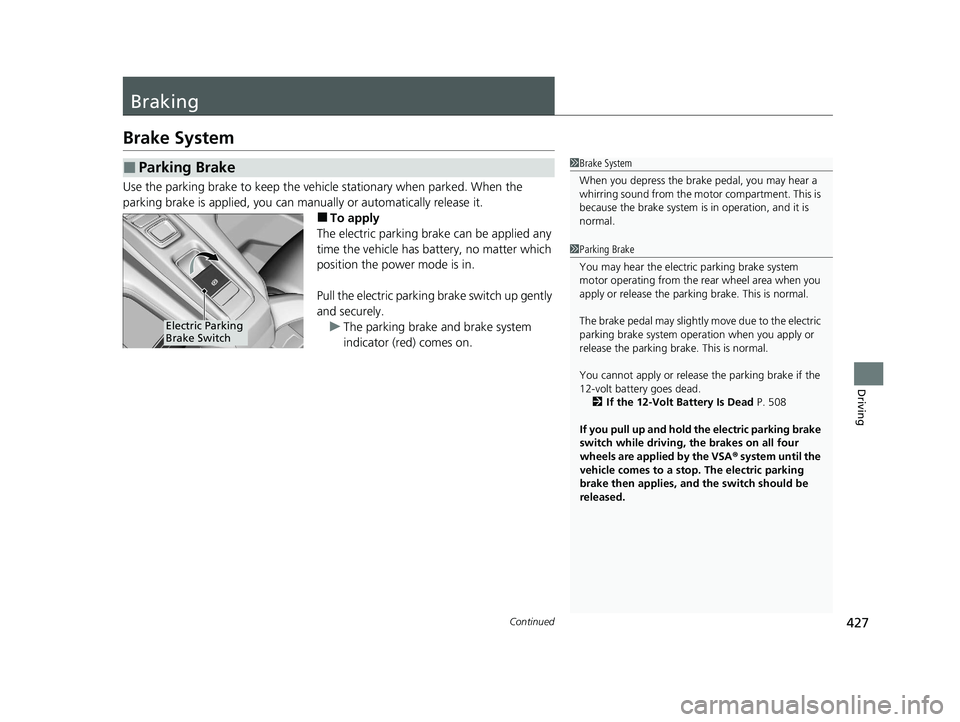
427Continued
Driving
Braking
Brake System
Use the parking brake to keep the vehicle stationary when parked. When the
parking brake is applied, you can manu ally or automatically release it.
■To apply
The electric parking brake can be applied any
time the vehicle has battery, no matter which
position the power mode is in.
Pull the electric parking brake switch up gently
and securely. u The parking brake and brake system
indicator (red) comes on.
■Parking Brake1Brake System
When you depress the brak e pedal, you may hear a
whirring sound from the motor compartment. This is
because the brake system is in operation, and it is
normal.
1 Parking Brake
You may hear the electric parking brake system
motor operating from the re ar wheel area when you
apply or release the parki ng brake. This is normal.
The brake pedal may slightly move due to the electric
parking brake system opera tion when you apply or
release the parking br ake. This is normal.
You cannot apply or release the parking brake if the
12-volt battery goes dead. 2 If the 12-Volt Battery Is Dead P. 508
If you pull up and hold the electric parking brake
switch while driving, the brakes on all four
wheels are applied by the VSA ® system until the
vehicle comes to a stop. The electric parking
brake then applies, and the switch should be
released.
Electric Parking
Brake Switch
21 CLARITY FCV CSS-31TRT6400_02.book 427 ページ 2020年9月25日 金曜日 午 後3時15分
Page 430 of 555
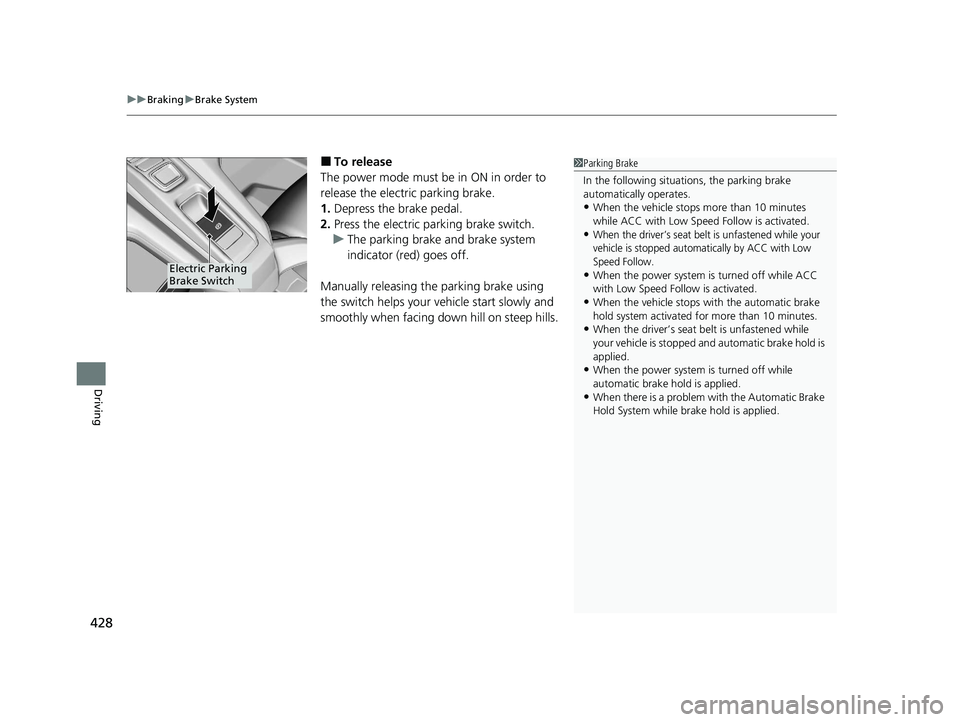
uuBraking uBrake System
428
Driving
■To release
The power mode must be in ON in order to
release the electric parking brake.
1. Depress the brake pedal.
2. Press the electric parking brake switch.
u The parking brake and brake system
indicator (red) goes off.
Manually releasing the parking brake using
the switch helps your ve hicle start slowly and
smoothly when facing down hill on steep hills.1 Parking Brake
In the following situations, the parking brake
automatically operates.
•When the vehicle stops more than 10 minutes
while ACC with Low Speed Follow is activated.
•When the driver’s seat belt is unfastened while your
vehicle is stopped automatically by ACC with Low
Speed Follow.
•When the power system is turned off while ACC
with Low Speed Follow is activated.
•When the vehicle stops with the automatic brake
hold system activated for more than 10 minutes.
•When the driver’s seat belt is unfastened while
your vehicle is stopped a nd automatic brake hold is
applied.
•When the power system is turned off while
automatic brake hold is applied.
•When there is a problem with the Automatic Brake
Hold System while brake hold is applied.
Electric Parking
Brake Switch
21 CLARITY FCV CSS-31TRT6400_02.book 428 ページ 2020年9月25日 金曜日 午 後3時15分